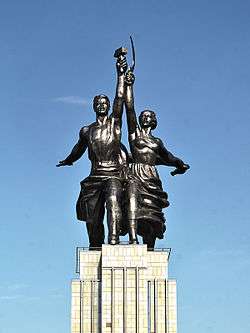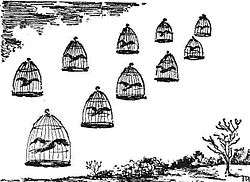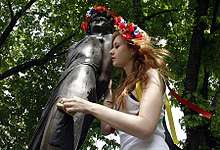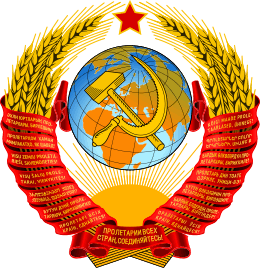Culture of the Soviet Union
The culture of the Soviet Union passed through several stages during the Soviet Union's 69-year existence. It was contributed to by people of various nationalities from every single one of fifteen union republics, although a slight majority of them were Russians. The Soviet state supported cultural institutions, but also carried out strict censorship.
| Part of a series on the |
| Culture of the Soviet Union |
|---|
 |
| People |
| Languages |
| Traditions |
| Cuisine |
| Festivals |
|
Art |
| Literature |
|
Music and performing arts |
| Sport |
|
Monuments |
|
Symbols
|
|
History
Lenin years
The main feature of communist attitudes towards the arts and artists in the years 1918-1929 was relative freedom, with significant experimentation in several different styles in an effort to find a distinctive Soviet style of art. In many respects, the NEP period was a time of relative freedom and experimentation for the social and cultural life of the Soviet Union. The government tolerated a variety of trends in these fields, provided they were not overtly hostile to the regime. In art and literature, numerous schools, some traditional and others radically experimental, proliferated. Communist writers Maxim Gorky and Vladimir Mayakovsky were active during this time, but other authors, many of whose works were later repressed, published work lacking socialist political content. Film, as a means of influencing a largely illiterate society, received encouragement from the state; much of cinematographer Sergei Eisenstein's best work dates from this period.[1]
Education, under Commissar Anatoliy Lunacharskiy, entered a phase of experimentation based on progressive theories of learning. At the same time, the state expanded the primary and secondary school system, and introduced night schools for working adults. The quality of higher education was affected by admissions policie that preferred entrants from the proletarian class over those from bourgeois backgrounds, regardless of the applicants' qualifications.[1]
Under NEP, the state eased its active persecution of religion begun during war communism but continued to agitate on behalf of atheism. The party supported the Living Church reform movement within the Russian Orthodox Church in hopes that it would undermine faith in the church, but the movement died out in the late-1920s.[1]
In family life, attitudes generally became more permissive. The state legalised abortion, and it made divorce progressively easier to obtain,[1] whilst public cafeterias proliferated at the expense of private family kitchens.
Stalin era
Arts during the rule of Joseph Stalin were characterised by the rise and domination of the government-imposed style of Socialist realism, with all other trends being severely repressed, with rare exceptions. For many notable Mikhail Bulgakov's works were not repressed, although the full text of his The Master and Margarita was published only in 1966. Many writers were imprisoned and killed, or died of starvation, examples being Daniil Kharms, Osip Mandelstam, Isaac Babel and Boris Pilnyak. Andrei Platonov worked as a caretaker and was not allowed to publish. The work of Anna Akhmatova was also condemned by the regime, although she notably refused the opportunity to escape to the West. During the time when the Party was trying to make Soviet regime more palatable to Ukrainians, a great deal of national self-determination and cultural development was tolerated. [2] After this short period of the renaissance of Ukrainian literature ended more than 250 Ukrainian writers died during the Great Purge, for example Valerian Pidmohylnyi (1901–1937), in the so-called Executed Renaissance. Texts of imprisoned authors were confiscated by the NKVD and some of them were published later. Books were removed from libraries and destroyed.
In addition to literature, musical expression was also repressed during the Stalin era, and at times the music of many Soviet composers was banned altogether. Dmitri Shostakovich experienced a particularly long and complex relationship with Stalin, during which his music was denounced and prohibited twice, in 1936 and 1948 (see Zhdanov decree). Sergei Prokofiev and Aram Khachaturian had similar cases. Although Igor Stravinsky did not live in the Soviet Union, his music was officially considered formalist and anti-Soviet.
Late Soviet Union


In the 1960s, 1970s, and 1980s, the Brezhnev era, a distinctive period of Soviet culture developed characterised by conformist public life and intense focus on personal life. In the late Soviet Union, Soviet popular culture was characterised by fascination with American popular culture as exemplified by the blue jeans craze.[5]
In arts, the liberalisation of all aspects of life starting from the Khrushchev Thaw created a possibility for the evolution of various forms of non-formal, underground and dissident art; still repressed, but no longer under the immediate threat of Gulag labor camps. Alexander Solzhenitsyn, who wrote the critical One Day in the Life of Ivan Denisovich, was awarded the Nobel Prize in Literature and subsequently exiled from the Soviet Union.
Greater experimentation in art forms became permissible in the 1970s, with the result that more sophisticated and subtly critical work began to be produced. The regime loosened the strictures of socialist realism; thus, for instance, many protagonists of the novels of author Iurii Trifonov concerned themselves with problems of daily life rather than with building socialism. In music, although the state continued to frown on such Western phenomena as jazz and rock, it began to permit Western musical ensembles specialising in these genres to make limited appearances. But the native balladeer Vladimir Vysotsky, widely popular in the Soviet Union, was denied official recognition because of his iconoclastic lyrics.
See also
- Index of Soviet Union-related articles
- State ideology of the Soviet Union
- Music of the Soviet Union
- Cinema of the Soviet Union
- Censorship in the Soviet Union
- Demographics of the Soviet Union
- Religion in the Soviet Union
- Drug policy of the Soviet Union
- Culture of Belarus
- Culture of Russia
- Culture of Ukraine
- Soviet people
- Soviet cuisine
- Family in the Soviet Union
- History of Russian animation
- List of Russian-language novelists
- List of Russian-language poets
- List of Russian-language playwrights
- Fashion in the Soviet Union
References
-

- "Ukrainization". www.encyclopediaofukraine.com. Retrieved 2019-06-30.
- Poroshenko signed the laws about decomunization. Ukrayinska Pravda. 15 May 2015
Poroshenko signs laws on denouncing Communist, Nazi regimes, Interfax-Ukraine. 15 May 20
Goodbye, Lenin: Ukraine moves to ban communist symbols, BBC News (14 April 2015) - Ukraine celebrates Day of Victory over Nazism in World War II, UNIAN (9 May 2016)
- As of this edit, this article uses content from Wikinfo, a source licensed under the terms of the GNU Free Documentation License which was imported into Wikipedia before November 2008 and is therefore validly licensed for use on Wikipedia. All relevant terms must be followed. The original article was at "Culture of the Soviet Union".
